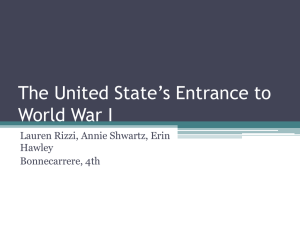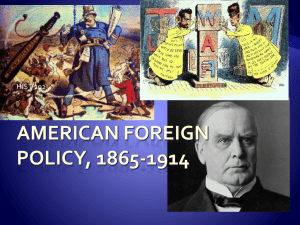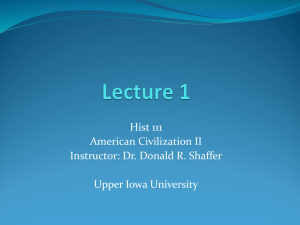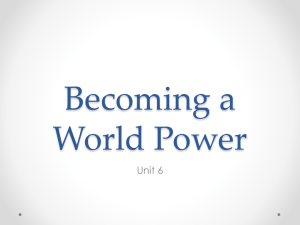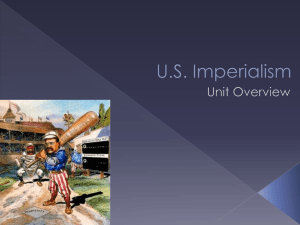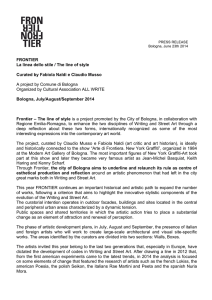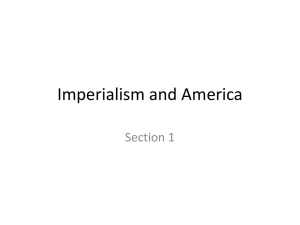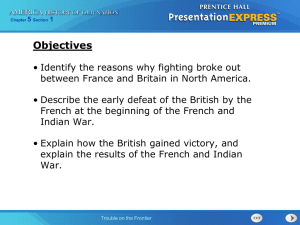ImperialPower
advertisement
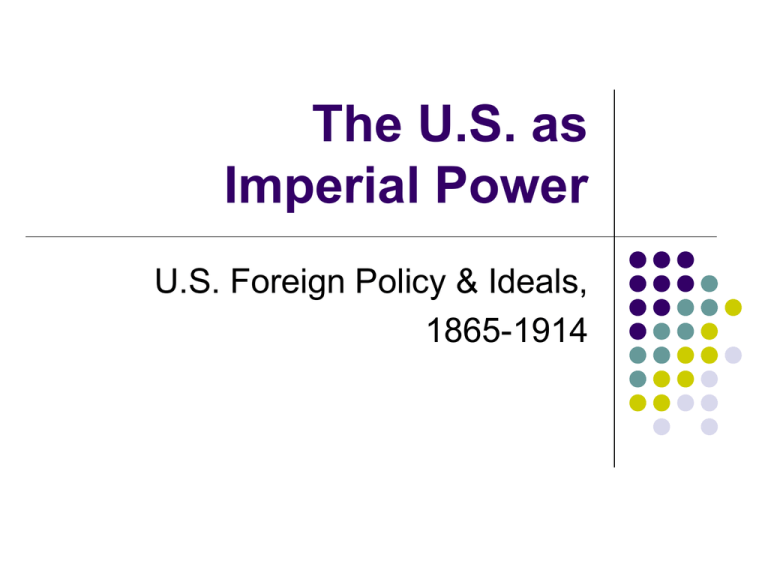
The U.S. as Imperial Power U.S. Foreign Policy & Ideals, 1865-1914 U.S. Standing in the World – Contradictions Post-Civil War army smaller than Bulgaria’s Navy old and decrepit But expansionist tendencies An industrial, financial, economic power Growing economic internationalism Increasing involvement in world diplomacy Strong imperial sentiments based on race, nationalism, power Expansionist Tendencies Treatment of Native Americans Philosophy of civilizing Native Americans, such as the Dawes Act Manifest Destiny – rationale for U.S. right to territorial expansion Religious explanations for expansion – Godgiven right Frontier thesis – end of frontier, what now? John Gast, Manifest Destiny, 1872 Economic Expansionism Search for new markets for goods produced by growing industrial power – oil, machinery, steel, etc. Needed to export goods to maintain prices and employment since many in U.S. couldn’t buy goods themselves - underconsumption Search for raw materials Desire for new exotic, luxury, and leisure goods, new consumer goods for growing middle-class Cuba and the SpanishAmerican War, 1890s American interests: Pro-intervention in Cuba – Jingoists Pro-Cuban independence – those Americans who believed in self-determination; against Spanish military atrocities Pro-war expansionist imperialists William Randolph Hearst, yellow journalism, trying to sell papers Rising tide of American public; sinking of Maine USS Maine Entering Havana Harbor, Jan. 1898 USS Maine Sunk, Feb. 1898 “Remember the Maine” Souvenirs (on Ebay) Specifics of the War War began April 24, 1898 Two fronts: Cuba in Atlantic; Philippines in Pacific Cuba: U.S. badly prepared to go to war, but Spain weak and demoralized More men on both sides died from disease than fighting Philippines: Dewey defeated Spanish fleet Base for economic interests in China Basis for acquisition of other territories: Hawaii, Guam Jacksonville, FL Fever Ward for U.S. Soldiers, 1898 Teddy Roosevelt: War, Race, and Masculinity War was a chance to “manufacture manhood” (Senator Beveridge) Teddy Roosevelt and the Rough Riders War could prove U.S. power and might Could replace frontier as crucible of American “race” and masculinity TR’s new American Race: chose a mix of diff. types and races for RR: cowboys, miners, Scots-Irish, Ivy-Leaguers, Native Americans, a Jew, Italians, Scandinavians, 4 NY policemen – a chance for in-between people to become American No blacks or Asians, the weaker races would dilute and weaken the race Fears of Over-Civilization Neurasthenia, an official, diagnosed illness “American Nervousness” – the stress and strain of modern life Threat of “brain work” and becoming too cultured Debilitating to middle-and upper-class men and women Various cures: Rest for women Strenuous exercise & masculine pursuits for men Western hunting trips, vacations Patent Medicine Cures Get Some Moxie Moxie Nerve Food Invented in 1876 by Dr. Augustin Thompson To cure everything from "softening of the brain" to "loss of manhood" TR and the National Parks Thomas Moran, “Tower Creek,” 1871 Yellowstone Survey Expedition The West & the American Vacation Race and Masculinity on San Juan and Kettle Hills TR led RR charge up hills, rallied regular troops, won control of positions, affirming superiority of American “race” But U.S. black regulars had major role in winning the hills, complicating the story At the time, TR and press gave credit to black troops: “an excellent breed of Yankees” But when he wrote history of RR, he criticized black troops for being “dependent” on white officers, had been cowards He rewrote history of event to affirm racial superiority of American “race” w/o blacks War as Crucible War heightens ideology, differences, conflicts, and meaning War seen as test; symbols, rhetoric, ideals = what is America? Groups and individuals used war as means to achieve status and self-worth In-between people, new immigrants, and blacks saw war as means of achieving higher status and recognition as true Americans In-between new immigrants succeeded and would again in WWI and WWII Black soldiers did not; their role edited out of victory Editing out Black Troops: TR and the Rough Riders on San Juan Hill The Rough Riders by Mort Kunstler Black Soldiers, Circa 1898 For Love of Liberty Video Link Colored Cavalry, Battle of Quasimas, Cuba Outcome: U.S. Empire Treaty of Paris, 1898, ended Spanish-Am. War Granted U.S. control of: Cuba & Puerto Rico in the Caribbean Guam and the Philippines in the Pacific How would new empire affect U.S. history? Mentality about the world Interests Military Economics The Problem of Empire: FilipinoAmerican War, 1898-1902 Philippines problem: Can U.S. live up to ideals as head of American empire, subjection of people? What to do with the Philippines?: just keep base, partition, independence? Filipino independence movement led by Emilio Aguinaldo; wanted Philippine Republic; Freedom Fighters – what would Americans do? Pres. McKinley: “we could not leave [the Filipinos] to themselves – they were unfit for self-rule – and they would soon have anarchy and misrule over there worse than Spain’s was” John Sayles’ Amigo trailer Filipino-American War, 18981902 Anti-imperialists: to have empire was against Am. ideals, anti-colonial past Other anti-imperialists didn’t want to deal with lesser people like Filipinos, afraid that they would be incorporated into U.S. Guerilla war: U.S. resorted to Spanish methods: concentration camps, attacks on villages, atrocities TR defended U.S. troops and war of “civilization” against “savagery” How does a nation live up to its ideals when fighting a war? Anti-imperialist cartoon by Charles Nelan: the risks of “incorporating” the Philippines into the U. S.; Filipinos were “savage” and incapable of exercising political rights and would threaten U.S. institutions Pictures of dead Filipinos were often taken by U.S. troops and labeled with captions such as this: “‘Can the __d Regiment boys shoot? You bet they can. Count the dead niggers.’ Conclusions Growing U.S. internationalism: diplomatic, economic, imperial Internationalism and war created conflicts over American ideals War as Crucible – heightened emotions, use of symbols Spanish-Am. War used as means to solidify racial and gender lines In-between people used war to gain American identity and acceptance Race wars and empire threatened American ideals U.S. Global Power & WWI Major Themes Growing U.S. interventionist foreign policy Foreign policy differences Increasing power of state during wartime War as Crucible Defining the nation during wartime – who is included? War as method of assimilation for immigrants T.Roosevelt and U.S. Foreign Policy Role in Spanish-American War Presidential Policies: Alliance with Britain Feared world war Believed he and U.S. should take active role in world affairs Powerful nations had right to dominate weaker T.R. – speak softly: negotiated peace settlements (Japan vs. Russia, 1905) Theodore Roosevelt and his Big Stick in the Caribbean, 1904 by William Allen Rogers T.R.’s Big Stick T.R.: Exert military power when necessary Need for modern navy to exert world power U.S. intervention in Western Hemisphere (Monroe Doctrine): Caribbean and Latin America: Haiti, Dominican Rep., Nicaragua, Cuba Panama Canal: U.S. incited rebellion to get access China: U.S. contributed troops to put down Boxer Rebellion, maintain China’s Open Door to Europeans and Americans T.R.’s ‘New Nationalism’ on Economic Matters Relationship between economic, social, and foreign policies Modern world creates powerful institutions – can be harnessed to improve people’s lives Govt. power must rival corporate power Govt. protects the public interest “Combinations in industry are the result of an imperative economic law which cannot be repealed by political legislation. The effort at prohibiting all combination has substantially failed. The way out lies, not in attempting to prevent such combinations, but in completely controlling them in the interest of the public welfare” (1910 New Nationalism speech) Taft and Dollar Diplomacy W.H. Taft became Pres. In 1908 Quickly distanced himself from T.R. More conservative personality Believed economic interests and trade should be at forefront of foreign policy Economic investment = better relations Continued T.R.’s interventionist policies in Latin America But supported arbitration of disputes, rather than war Wilson’s Foreign Policy U.S. foreign policy should not be based on economic interests (against Taft) Foreign policy should be based on American ideals Freedom Self-determination of all nations (anti-T.R.) Free markets Spreading opportunity “make world safe for democracy” World War I: International Context European Imperialism – divided up Africa, Middle East, South America European Alliance System Competition for power, status, colonies, empire among European nations Formation of alliances with other nations Triple Alliance: Germany, Austro-Hungary, Italy Triple Entente: UK, France, Russia If one nation in alliance was attacked, others would come to aid U.S. Anti-Interventionists Many different, sometimes contradictory, sentiments against U.S. interventionist foreign policies no entangling alliances, particularly in European affairs (George Washington) isolationism peace movements against colonialism/imperialism/racism against corrupting influences of foreign affairs American exceptionalism - ideals and institutions should keep us separate Immediate Causes of War 1914 Gavrilo Princip, a Bosnian terrorist, assassinated Franz Ferdinand, the heir to the Austro-Hungarian throne, in Sarajevo Princip wanted independence of Slavic peoples from Austro-Hungarian Empire Caused all of the alliances to come into effect Germany invaded Belgium, Luxembourg, France Austro-Hungary invaded Serbia Russia attacked Germany UK entered war to defend France War Conditions & Fronts Increased technology from U.S.: machine-gun, long-range rifles created advantage for defensive positions (trench warfare/stalemate) German advance on Paris halted - Western front fight over swath of land across Belgium and northern France Eastern front - Germany attacked Russia (led to Russian Revolution) Attempts to break stalemate: German attack at Ypes in 1915 used poison gas; Verdun in 1915, huge casualties of near 500,000 on both sides U.S. Attitudes Towards WWI Opposition to U.S. entry into the war: Socialists and the Left African American leaders not interested in war among white imperialist nations Carnegie and Ford LaFollette and other politicians Women’s Peace Party Divided loyalties of other Americans: pro-British, anti-British Irish, pro-German, immigrants from various parts of A-H empire Pressures for War Growing ties with Allies Imbalance of trade favored Allies, not Germany Official neutrality, but trade on seas not allowed with either side, dragged U.S. into war German U-boat attacks to prevent shipments to Allies, sinking of Lusitania in 1915 Wilson ran on Progressive and antiwar planks, narrowly won 1916 election Wilson changed opinions: supported buildup of U.S. military after Lusitania and failures to broker peace Pressures for War (continued) Jan. 31st, 1917 Germany declared unlimited submarine warfare Zimmerman telegram from Germany to Mexico promised M that they could recover lost territories if M joined Triple Alliance – angered U.S. Growing bellicose attitude b/c of German telegram, Mexican incursions in SW, and U-boat sinkings April 2, 1917 Wilson requested declaration of war, make world “safe or democracy,” not material gain Four days later, Congress declared war; Europe requested troops To Build an Army U.S. had never fielded large army that quickly Selective Service Act of May 1917 – wartime draft Local draft boards examined recruits Diversity of AEF: 49 diff. language readers for censoring U.S. servicemen’s mail Segregated armed forces - much higher rate of conscription for black soldiers – didn’t have connections to get out of service To Build an Army (continued) First military action was to escort troop and merchant ships to Europe, cutting losses by more than half Pershing waited to use AEF ground forces until fully trained Russian Revolution ended Eastern Front Germany made push for Paris U.S. committed first 60k troops at Chateau-Thierry and Belleau Wood in May and June 1918 Put in 1million men to push Germans back Helped end war by Nov. 1918 The Home Front: Economics ¼ of gdp went to war at height Combination of voluntarism and growth of govt. power – largely successful U.S. became creditor nation Used income tax to pay for war, on wealthy and excess profits of corporations Liberty Loans The Home Front: Building a New U.S. State T.R.’s New Nationalism put into practice War Industries Board under Bernard Baruch – gathered data, allotted scarce resources, ordered factories to convert to war production, set prices Drastic measures: Fuel Administration closed all eastern factories for 3 days and raised price of coal to deal with coal shortage; seized control of railroads Food Administration very successful - Herbert Hoover increased production, decreased consumption Government controls dismantled by Wilson in 1918, despite some calls to keep them to deal with postwar problems The Home Front: Labor Labor’s position improved during war, although got less than owners Gompers participated in National Defense Advisory Commission - official recognition for labor, place at table National War Labor Board dictated 8-hour day, pay for overtime, equal pay for women One million growth of AFL during war, growth in stature and respect for labor movement Black, Mexican, and women workers gained industrial positions, but lost them when war ended Great Migration of black workers to the north and industry The Home Front: Economic Democracy Efforts to use war and war rhetoric to fight for progressive and labor causes War should spread real democracy at home as well as abroad Democracy not just political; there should be economic democracy too Use expanded power of state to benefit workers Keep controls on industry after war to ensure good wages, employment, economic equality, prevent depressions The Home Front: Women’s Suffrage Women used war to gain suffrage National American Woman Suffrage Association put 2 million members behind Wilson’s war effort Alice Paul and National Womens Party picketed White House to push for vote Wilson started suffrage vote as a “war measure” Start worldwide democracy movement at home Aug. 26, 1920, TN was last vote in favor of amendment The Home Front: AntiDemocratic Measures Question: How to get popular support for war? – many opponents to war Question: Does war effort require unanimous support? Conformity? Attempts to shape national unity George Creel and wartime propaganda 1917 Wilson formed Committee on Public Information to mold public opinion on war, promote nationalizing ideology Patriotic literature, 4-minute men to give speeches The Home Front: Forced Consensus Creel & expectation of cultural conformity – Get on board the war effort Patriotism = Support for War American Protective League, a vigilante group: 250,000 self-appointed agents to weed out draft evaders and traitors Attacks on leftists, pacifists, and immigrants The Home Front: 100% Americanism Public campaign for full loyalty Urged immigrants and others to become 100% American Anti-German campaigns, changed names Espionage Act of 1917, Sedition Act of 1918: outlawed disloyal speech, writing, and behavior Crackdown on antiwar, socialists, leftists, Eugene Debs Conviction of over one thousand people Sept. 1917 arrest of 113 IWW leaders The Home Front: Debs in Jail The Home Front: War Posters Attempts to unify nation in support of war Common methods Public displays, posters, parades 100% Americanism Patriotism = Sacrifice Different Roles for Men and Women Creating the savage “Other” – use of fear and racial imagery Expansionism: The West Case study: Columbian Exposition, 1893: a site where American racial and frontier ideas were worked out, exhibited Chicago: a western city, railroad city, cattle, grain, immigration 1893 Exposition: 400th Anniv. of Columbus/New World – festival commemorating Euro. settlement The White City – white progress, civilization – architecture, tech., arts The Midway offered comparisons to other “races”, “primitives” Expo. offered vision of what whites wanted the rest of the west to become Staging the West: Turner and Buffalo Bill 2 versions, 2 men – enactment of western myth in 1893 F.J. Turner – historian, “frontier thesis” Frontier = progress = democracy Democracy on frontier - farm families, Indians irrelevant, individualism, new Americans, econ./phys. mobility 1890 U.S. Census declared frontier closed – Turner wondered about what that would mean for American character Buffalo Bill – story of frontier conflict, whites and N.A., whites under attack, justified fight against N.A. Used images of conflict, heroic martyr (Custer) White frontier men “know” Indians, then beat them Staging the West: Turner and Buffalo Bill (continued) Similarities: Whites justified in taking over “empty” continent Conquest = a good thing A “clean” story of “progress” Used symbols, images, and stories that Americans knew, even if not historically correct Turned attention away from Reconstruction and ‘nigger problem’ – the West was story of national success, regeneration of democracy and nation through frontier experience Chicago -The Frontier West Reenacted: Buffalo Bill, The White City, The Midway, and F.J. Turner Indians and Conflict; Buffalo Bill Cody, the showman Frontier Myth in American History If American west closed in 1890, and it meant so much to American psyche, then what?

